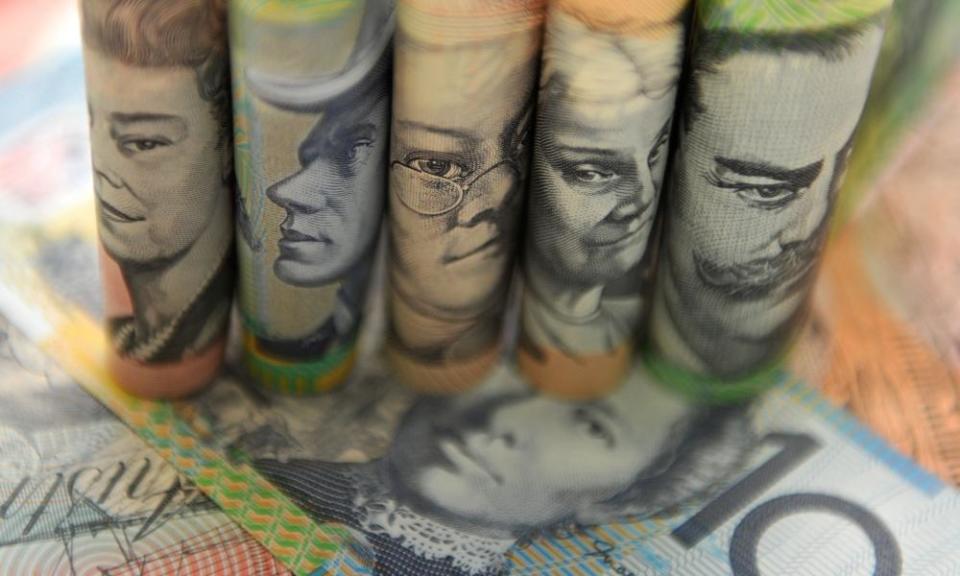Middle Australia earns $100,000 and has a negatively geared property? Not true

The latest taxation statistics, released last week by the ATO, reveal just how skewed the political narrative is towards those on high incomes and how negative gearing continues to mostly benefit those who earn well above median incomes.
This Thursday’s economic statement will, as with most budgetary announcements, come with plenty of talk about middle Australia. And the government will be desperate to pretend that someone earning around $100,000 a year is on a middle income, despite that being nearly double what half of Australians earn.
Related: Bringing forward tax cuts is giving to the wealthy when we can least afford it | Greg Jericho
They do this because the benefits of tax cuts or deductions such as negative gearing are inherently skewed towards higher income earners.
The latest ATO tax statistics revealed that in 2017-18 the median taxable income for Australians was just $45,882 – and for women specifically it was a mere $39,058:
This figure is a bit lower than it should be because it takes into account all 14 million people who put in a tax return in 2017-18. But not everyone has to pay tax – most of those who earn less than $18,200 don’t.
If we only count those who did have to pay tax – around 10.6m of us – then the average and median incomes rise a bit.
But only a bit, and not enough to justify any government minister talking about those earning over $100,000 as middle income Australians.
The median income in 2017-18 of those who paid tax was $57,245. Even the average, which is skewed by high income earners, was just $78,282 – below those for example who would benefit from the 37% marginal tax threshold being raised from $90,000 to $120,000, as the government intends to do:
The tax statistics are thus a nice corrective to political discourse, although sadly a corrective that is often forgotten.
The treasurer for example last year, when arguing for the government’s tax cuts, suggested that “someone who is on the average full-time earnings in 2024-25 – that will be around $100,000 – they will be $1,375 worse off as a result of repeal of such legislation.”
Leaving aside the need to extrapolate out five years to get an average income that will benefit from the tax cuts, the reality is average full-time earnings are greatly above the median taxable income.
In 2017-18 the average full-time earnings was $85,857 – such an amount would put that person in the top 25% of taxpayers:
Apart from spruiking the benefits of tax cuts for those earning more than $100,000, where we see the definition of “middle Australia” distorted most is when talk turns to negative gearing.
In 2017-18, just over 12% of all taxable individuals were negative gearing – claiming a total of $12.2bn in rental losses.
The percentage of us negative gearing has actually been declining since 2012-13 – because interest rates have also been declining. It is harder to claim a loss on your rental property when the interest you are paying is falling:
But the benefits of negative gearing remain skewed towards high income.
In 2017-18, while nearly 80% of people had a total income (ie before taking into account deductions) of less than $80,000, they accounted for just on 60% of those who did negative gear and yet claimed only half the total amount of rental losses.
By contrast, those earning over $180,000 made up just under 4% of all individuals but they claimed 16% of all the rental losses:
And yet when you hear the prime minister talk of negative gearing it is always about “middle Australians”.
For example he told parliament in 2018, while arguing against the ALP’s then policy to halt negative gearing on existing properties, that “every time they try and buy an investment property – because one in five police officers do, and thousands of nurses and thousands of teachers do – you’re going to whack tax up on them”.
Except analysis of the tax statistics shows the likelihood that someone in an occupation is negative gearing is very strongly linked with the average income of that occupation:
Surgeons and anaesthetics, who are the two highest paid occupations, are also the two occupations most likely to include negative gearers.
Primary school teachers actually negative gear less than the average – just 11.4%. Secondary school teachers are just above average negative gearers – 14.4% of them do so. But the real negative gearers among educators are school principals, but then, with an average income of $127,000, they are decidedly not “average”.
The police certainly are big negative gearers. Scott Morrison is right – about one in five negative gear.
But the sneaky secret about police is, while it might sound like a middle Australian occupation, they are actually very well paid:
The median income for a “police investigator” (the most common form of police officer in the tax statistics) in 2017-18 was $96,675 – putting them in the top 19% of all taxpayers, and well above the median income – male detectives were in the top 13%.
The latest taxation statistics are thus a nice reminder that when you often hear a government minister talk about middle Australia, they are talking about people who earn more than 80% of us. And it is instructive that they never make the error in the other direction.
• Greg Jericho writes on economics for Guardian Australia

 Yahoo Finance
Yahoo Finance 